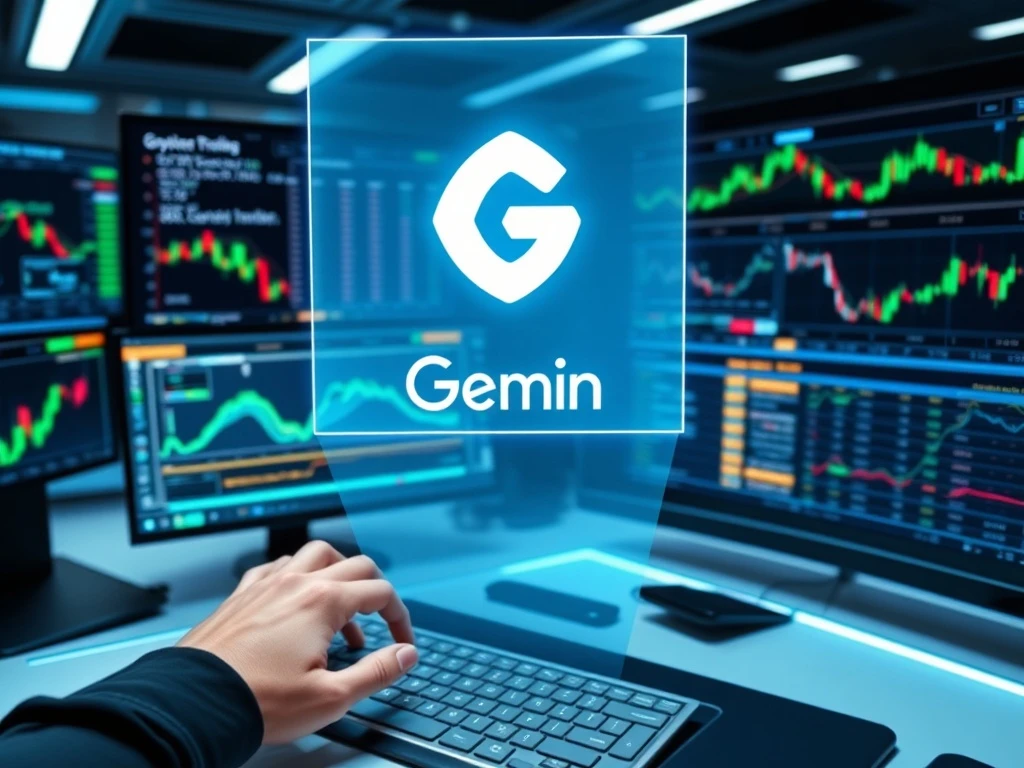Unlock Success: 7 Ways Google Gemini AI Revolutionizes Crypto Day Trading

Navigating the volatile world of **crypto day trading** can feel like an impossible challenge. The market never sleeps. Prices swing wildly. News breaks constantly. However, advanced tools are now available to help traders. Google’s **Gemini AI crypto** assistant offers a powerful new approach. It helps cut through the noise, manage risk, and act on market catalysts with greater confidence. This article explores how Gemini AI can become your indispensable co-pilot in the fast-paced crypto market.
Mastering Crypto Day Trading with Google Gemini AI
Day trading in crypto means opening and closing positions within the same day. Often, this happens within hours or even minutes. Unlike swing traders who ride trends for days, day traders thrive on short-term price movements. Volatility is their primary playground. Crypto markets offer this in overdrive, creating both opportunity and significant risk. Furthermore, unique aspects of crypto markets amplify this intensity:
- 24/7 Markets: There is no closing bell. Bitcoin (BTC) can break out at 3 AM.
- Narrative-Driven Pumps: A token upgrade or a social media post can flip sentiment instantly.
- Liquidity Pockets: Order books thin out quickly. Slippage can severely impact an unplanned entry.
- Noise Overload: Telegram, X, Discord, on-chain alerts, and macro news all compete for attention. Hundreds of signals flood traders daily.
This is precisely where AI tools like **Google Gemini** become invaluable. They do not replace the trader. Instead, they act as a smart co-pilot. Gemini AI assists by:
- Summarizing order flow and sentiment.
- Filtering key catalysts from background noise.
- Structuring data into clear sheets or dashboards.
- Helping you write, test, and refine trading rules.
This approach helps prevent chasing FOMO. It empowers traders to make more informed decisions.
Understanding Gemini AI’s Capabilities for Crypto Day Trading
Google’s Gemini AI offers distinct advantages for active traders. Its ability to reason over large contexts is particularly strong. Newer Gemini releases, such as Gemini 2.5 Pro, excel at this. They can stitch together vast amounts of market data and your personal notes. This results in actionable summaries. Moreover, Gemini integrates seamlessly across Google Workspace apps. This includes Docs and Sheets. Here, it can summarize data, clean it, and generate charts. In-cell AI functions in Sheets make this even easier. For developers, Google AI Studio and the Gemini API provide programmatic access. You can prompt models, analyze data sets, and integrate outputs into custom scripts or dashboards.
However, it is crucial to understand Gemini’s limitations. Gemini AI should not directly hold crypto keys. It must never auto-trade unsupervised. Keep Gemini focused on analysis, signal generation, backtesting, and alerts. If you connect it to an exchange API, strictly gate permissions. Ensure it only performs authorized tasks. Gemini Flash 2.5, the latest version, still lacks real-time data access. Therefore, always pair it with live data from tools like TradingView, Glassnode, or Nansen. You must cross-check AI-generated insights against live charts and reliable sources. Crypto markets are highly volatile. Always conduct your own research and trade responsibly.
Setting Up Your Workspace for Effective AI Trading Strategies
To effectively leverage **AI trading strategies** with Gemini, setting up a structured workspace is essential. First, select your Gemini access level. Developers can use Google AI Studio and an API key for custom prompts and scripts. For no-code research and dashboards, Gemini in Workspace (Docs/Sheets) is ideal. Google now bundles “Advanced” features under the Google AI Pro subscription. This offers bigger context windows and deeper research capabilities. If you manage multi-asset intraday notes, this can be very beneficial.
Next, create a dedicated trading notebook in Google Sheets. This structured space helps Gemini AI organize market chaos into clarity. A simple Google Sheet with six tabs provides an excellent starting point:
- Watchlist: Track tokens you are monitoring.
- Catalysts: Note key events like upgrades, unlocks, or macro reports.
- Levels: Mark out support, resistance, and liquidity pockets.
- Order Flow: Capture on-chain flows, funding rates, or order book imbalances.
- Plan: Write your playbook before each trading session begins.
- Post-Mortem: Log what worked, what failed, and what to improve.
This creates a repeatable trading loop. It moves from Watchlist to Catalysts, then Levels, Plan, Order Flow, and Post-Mortem, finally returning to the Watchlist. Gemini slots into each step as a powerful reasoning partner. You can manually create data sets. Alternatively, you can run this trading loop using data sets downloaded from analytics providers like Glassnode, TradingView, or CryptoQuant. This systematic approach enhances your decision-making process.
Practical Examples of Gemini AI in Crypto Day Trading
Let’s explore practical applications of **Gemini AI crypto** in your daily trading routine:
Refining Your Watchlist with Google Gemini
Imagine your watchlist includes Bitcoin (BTC), Cardano (ADA), and Solana (SOL). Instead of manually scanning dozens of tokens, you can ask Gemini to highlight key performers. For example, you might ask it to identify coins with the biggest market swings. You could also request the highest percentage changes in the past 24 hours. This data would come from your own feed or an external platform. A prompt might look like this: “Summarize the top three coins by 24-hour price change from this data set. Rank them by potential risk of shorting.” Gemini will provide structured context and a ranking. This helps you focus your limited time on the most volatile assets, based on the data provided.
Catalyst Filtering for Informed Decisions
Catalysts drive intraday moves. These include Consumer Price Index reports, US Federal Reserve minutes, token unlocks, or even airdrop rumors. However, noise often outweighs actual signals. Instead of scrolling endlessly through X or Discord, paste headlines into Gemini AI. Then, ask a specific question: “Flag which of these news catalysts are most likely to impact ETH and SOL in the next 12 hours, based on past price reactions.” Gemini AI can quickly identify relevant news. This allows you to react faster to market-moving events.
Mapping Levels and Liquidity
Support and resistance levels are fundamental to day trading. While Gemini cannot stream live order books, it can process your data. Feed it recent OHLCV (open, high, low, close, and volume) data or your own notes. Then, ask: “Identify the key price clusters where ETH was rejected multiple times this week and summarize as possible resistance.” Instead of eyeballing charts, you receive a clear text summary. For instance, “ETH repeatedly rejected near $3,950-$4,000; prior support at $3,840 flipped resistance.” This provides precise, actionable insights.
Analyzing Order Flow Sentiment with AI
If you track open interest, long/short ratios, or whale wallet flows, Gemini AI can make sense of this complex data. Prompt it: “Summarize whether current BTC futures positioning looks more skewed to longs or shorts.” You still need the raw BTC data from your trading portals. However, Gemini AI’s summary helps avoid tunnel vision. It provides an interpreted snapshot. This tells you whether the crowd is leaning long, short, or neutral. This interpreted data is invaluable for quick decision-making.
Crafting Your Daily Trading Plan
The Plan tab is where **Google Gemini** helps enforce discipline. A prompt like: “Take today’s Watchlist, Catalysts, and Levels tabs and draft three possible intraday scenarios with triggers and invalidations.” This might generate an output such as:
- Scenario A: Ether (ETH) breaks above $3,000 on high volume; long scalp with stop at $2,960.
- Scenario B: BTC rejects $105,000 resistance again and fades into $100,000.
- Scenario C: SOL reacts negatively to unlock event; short bounce into $170.
Now, you possess a structured plan. This replaces impulsive, unorganized trading.
Post-Mortem Review and Learning
After a trading session, paste your trades into Gemini AI. Ask: “Analyze my last five trades and identify patterns in mistakes or strengths.” Gemini might spot that you cut winners too early. Perhaps it notes you let losers run. Or maybe it highlights overtrading during high volatility. This process transforms mistakes into structured lessons. It promotes continuous improvement in your **AI trading strategies**.
Enhancing Crypto Risk Management with Gemini AI
**Crypto risk management** is paramount for every day trader. Surviving bad trades often matters more than catching perfect ones. Use Gemini AI as a critical discipline check:
- Position Sizing: Share your account size and maximum risk per trade. Gemini AI can then calculate safe position sizes under different leverage scenarios. This ensures you never over-leverage.
- Scenario Planning: Do not map only bullish setups. Prompt Gemini AI to also outline bearish and sideways cases. This ensures you are never locked into one bias. It prepares you for all market conditions.
- Risk-to-Reward Ratios: Paste your planned setups into Gemini. Ask it to rank them by “r/r” ratio. This keeps your focus on the highest-quality trades. It prioritizes setups with favorable outcomes.
- Capital Allocation: Ask Gemini to summarize your exposure across assets. For example, it might highlight “too much ETH beta.” This allows you to rebalance before it is too late. It helps diversify your risk effectively.
Day trading crypto will always be a high-speed, high-risk game. **Google Gemini** AI offers more than just shortcuts. It provides the ability to process vast amounts of information. It helps you stick to your predefined rules. Moreover, it refines your strategies faster than you could ever achieve alone. This empowers traders to navigate complex markets with greater control and confidence. Remember, consistent research and responsible trading remain essential. This article does not contain investment advice or recommendations. Every investment and trading move involves risk. Readers should conduct their own research when making any decision.








